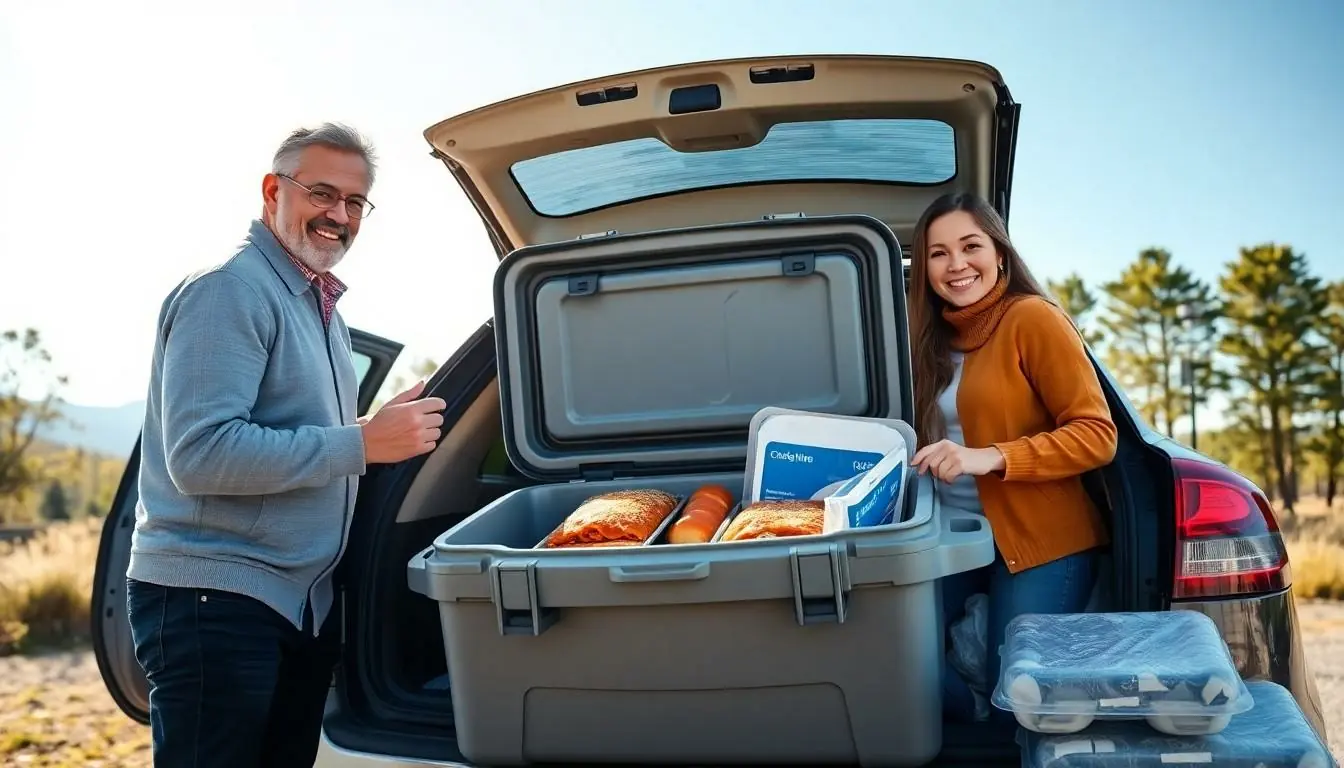Traveling with frozen food might sound like a culinary challenge, but it can be a game changer for those who love to savor their favorite meals on the go. Imagine this: you’re on a road trip, the open road ahead, and instead of settling for bland gas station snacks, you’re feasting on homemade lasagna. Now that’s what we call a food win!
Table of Contents
ToggleUnderstanding Frozen Food Travel
Traveling with frozen food offers simplicity and convenience during trips. With proper planning, keeping items frozen for extended periods becomes manageable. Choosing the right containers ensures that food remains intact and cold.
Selecting high-quality insulated coolers is crucial. Coolers equipped with thick walls provide better temperature retention. Utilizing ice packs or dry ice maintains a frozen environment that extends the food’s lifespan.
Packing food properly minimizes the risk of leaks and spills. Wrapping items tightly prevents contamination and preserves freshness. Storing items in a single layer within the cooler allows for optimal airflow.
Monitoring temperature throughout the journey keeps food safe. Carrying a food thermometer aids in tracking internal temperatures. If the thermometer registers above 32°F, consuming or refreezing may pose health risks.
Sorting food by type can enhance organization and accessibility. Keeping meats separate from vegetables prevents cross-contamination. Labeling containers with contents and dates streamlines meal planning on the go.
Understanding regulations for air and train travel is also essential. Some airlines enforce strict limits on carrying frozen food, while others may allow it with specific guidelines. Researching company policies beforehand saves time and avoids surprises at the terminal.
Incorporating these strategies facilitates successful frozen food travel. Enjoying homemade meals while on the road adds comfort and satisfaction to the journey. Embracing the benefits of traveling with frozen food transforms mealtime into a delightful experience.
Preparing Frozen Food for Travel

Preparing frozen food for travel enhances the enjoyment of meals on the go. Proper preparation ensures that food remains safe and delicious during the journey.
Choosing the Right Packaging
Selecting suitable packaging plays a critical role in maintaining food quality. Vacuum-sealed bags protect against freezer burn, while sturdy containers prevent leaks during transport. Resealable plastic bags offer convenience for individual portions. Additionally, insulated food containers can help retain temperature. Opt for materials that are easy to clean and reusable for sustainability. Prioritizing airtight packaging minimizes the risk of spoilage and preserves flavor.
Essential Tools and Accessories
Investing in the right tools and accessories simplifies the travel process. Food thermometers ensure that frozen items remain at safe temperatures. Ice packs or dry ice keep contents adequately chilled, especially during longer trips. An insulated cooler provides extra protection for maintaining cold temperatures. Packing tape helps secure lids on containers, reducing the possibility of spills. Having a sturdy cooler bag for additional insulation can further enhance temperature control. Preparing these essentials contributes to a smooth travel experience.
Transportation Methods
Traveling with frozen food requires specific methods to maintain quality and safety. Different modes of transportation entail distinct considerations.
Air Travel Considerations
When traveling by air, frozen food packaging must adhere to airline regulations. Containers should be leak-proof to prevent spills. Use dry ice or gel packs to keep food frozen during transit. Passengers typically limit dry ice to 5.5 pounds in carry-on or checked bags. A food thermometer helps monitor temperature during flights. Travelers also benefit from checking with airlines on restrictions for frozen items.
Road Trip Essentials
Packing frozen food for a road trip demands careful planning. A high-quality insulated cooler serves as a critical component. Ice packs or dry ice can maintain a consistent low temperature. Resealable bags provide convenient portion control, while sturdy containers minimize the risk of leaks. Organizing food by type in the cooler prevents cross-contamination and ensures ease of access. Regular temperature checks with a thermometer ensure food stays safely frozen throughout the journey.
Best Practices for Keeping Food Frozen
Maintaining the temperature of frozen food during travel is crucial for safety and enjoyment. Proper methods ensure meals stay frozen and delicious.
Using Dry Ice vs. Ice Packs
Dry ice offers a longer-lasting cooling solution compared to regular ice packs. It keeps food below freezing, making it ideal for extended trips. However, handling dry ice requires caution, as it can cause burns and emit carbon dioxide gas. Ice packs, on the other hand, are safer and easier to manage. They can be frozen ahead of the trip and placed alongside food in coolers. Using a combination enhances temperature control, combining both methods can boost effectiveness.
Ventilation and Temperature Control
Ventilation inside coolers is essential for maintaining consistent temperatures. Airflow prevents condensation and keeps items properly frozen. Coolers with built-in vents allow for better circulation. Regularly checking internal temperatures with a food thermometer ensures food stays at safe levels. It’s vital to pack food tightly without blocking vents, as a well-organized layout enhances cooling efficiency. Keeping coolers closed during travel prevents warm air from entering, preserving the frozen state of the food.
Safety Tips for Traveling with Frozen Food
Ensure food safety by packing frozen meals with care. Utilize sturdy, leak-proof containers to prevent any spills during travel. Monitor food temperatures regularly to guarantee proper freezing. A food thermometer plays a crucial role in this process, confirming that food remains at safe temperatures.
Use dry ice cautiously, as it can pose risks of burns or gas emissions. Store dry ice in insulated containers with ventilation to allow gas to escape. Choose ice packs for a safer alternative; they provide reliable cooling without the hazards associated with dry ice. Combining both methods can enhance temperature retention.
Keep coolers closed as much as possible to maintain a stable environment inside. Prioritize coolers with built-in vents to facilitate air circulation without losing cold air. Store food strategically, placing the most perishable items at the bottom and insulated items on top for optimal temperature management.
Consider travel regulations when flying or taking the train to avoid confiscation of your foods. Each airline or train service might have specific guidelines regarding frozen food and dry ice usage. Checking their rules beforehand prevents unexpected issues at security.
Remember that cross-contamination can lead to foodborne illnesses. Pack different food types separately, using containers for proteins and vegetables. Organizing food will help mitigate any risk of contamination during transit. Following these safety tips ensures that frozen meals remain delicious and safe throughout a journey.
Traveling with frozen food opens up a world of culinary possibilities on the go. By following the outlined strategies for packing and temperature management, travelers can enjoy their favorite meals wherever they roam. The right tools and techniques ensure that food remains safe and delicious throughout the journey.
Understanding regulations and best practices for different modes of transportation further enhances the experience. With careful planning and organization, mealtime can transform from a mundane necessity into a delightful adventure. Embracing the convenience of frozen meals not only saves time but also makes every trip more enjoyable.





